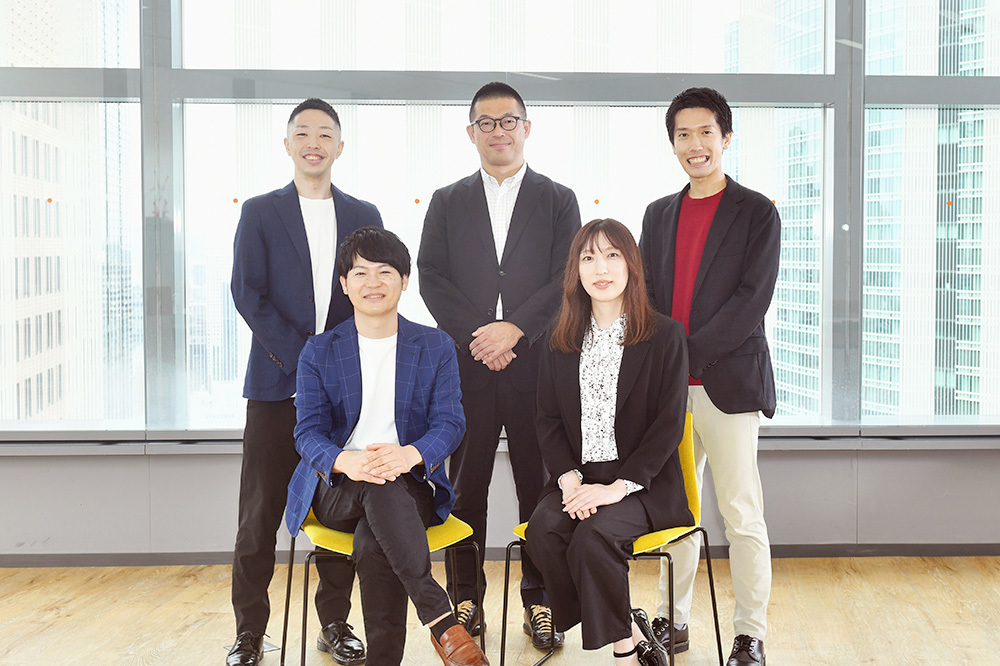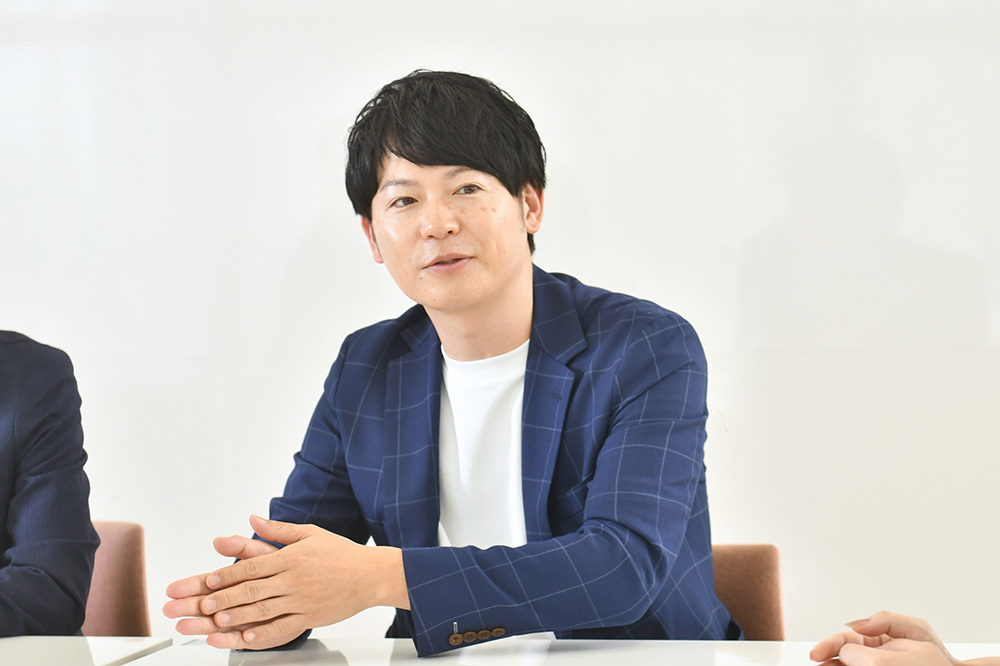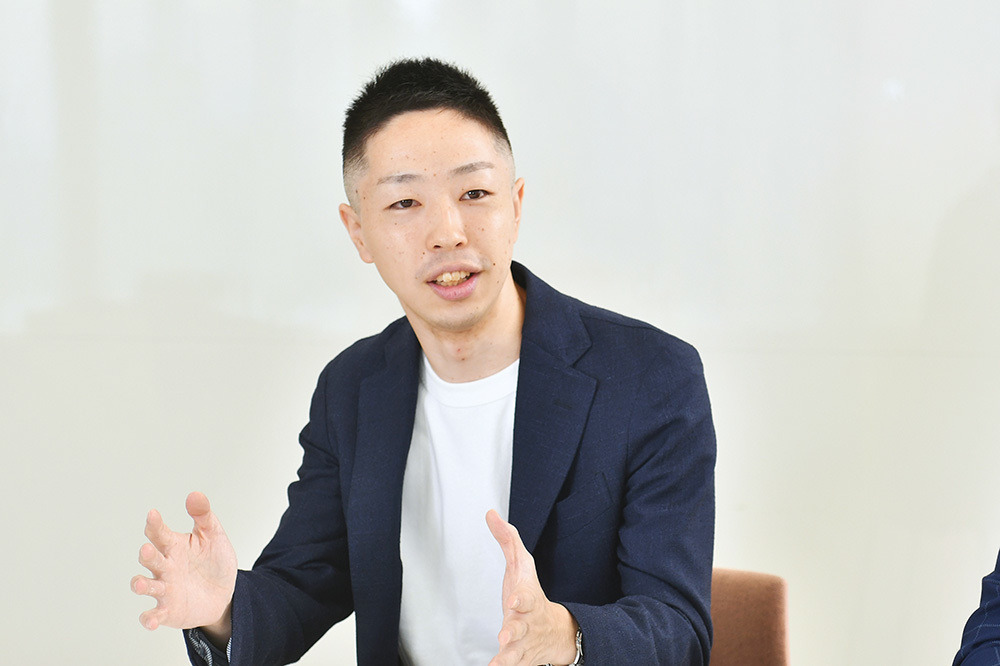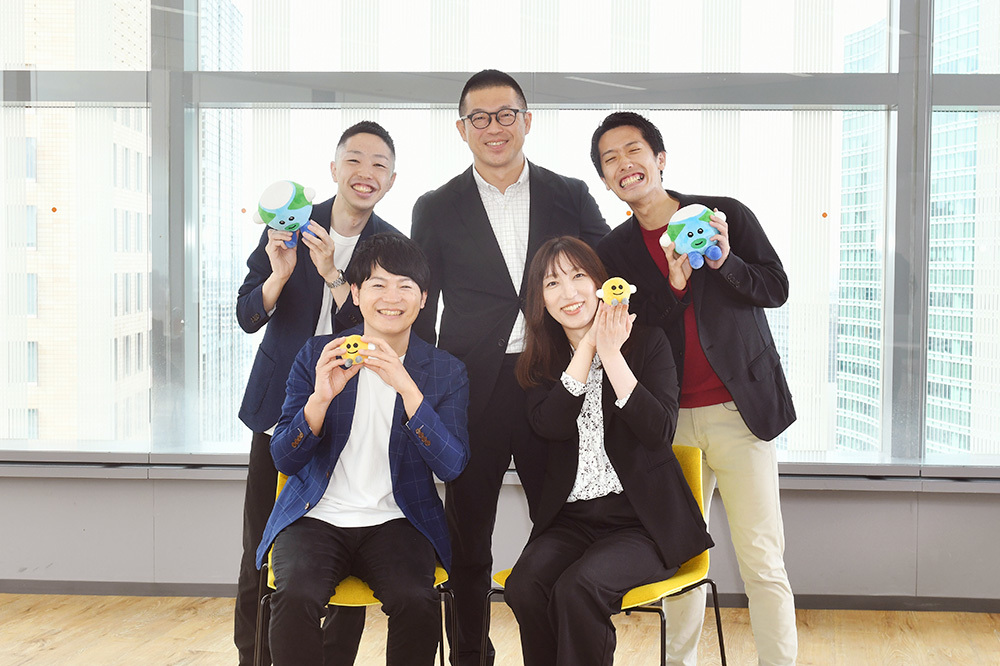
Front row, left to right: SmartNews' Ryohei Honda, Yuki Kawaharazuka; Back row, left to right: Dentsu Digital Inc.'s Yuta Kurihara, Dentsu Inc.'s Takeshi Okamoto, Shinnosuke Akazawa
The essential analytical environment for the era of data marketing is the "Data Clean Room" (DCR) provided by major platform operators.
Data Clean Rooms vary in their areas of expertise depending on the platform. The "SmartNews Ads Data Pot" (abbreviated as "Ad Pot") introduced here leverages SmartNews' strengths as a news app. Its key feature is the ability to utilize user behavior data, particularly "article reading behavior data," for user analysis and other purposes.
What challenges can SmartNews Ads Data Pot, jointly developed by SmartNews, Dentsu Inc., and Dentsu Digital Inc., solve for clients?
We present a roundtable discussion with the five individuals who advanced this project: Mr. Kawaharazuka, who develops data solutions at SmartNews; Mr. Honda from advertising sales; Mr. Okamoto from Dentsu Inc., the project leader; Mr. Akazawa, an analyst and project promoter; and Mr. Kurihara from Dentsu Digital Inc., responsible for SmartNews sales.
*In this article, the company name is written as "SmartNews" and the service name as "SmartNews".
SmartNews collaborates with Dentsu Inc. and Dentsu Digital Inc. to build "SmartNews Ads Data Pot," a data clean room supporting corporate marketing activities.
https://about.smartnews.com/ja/20240930
Users were reading SmartNews articles "x weeks before" purchasing the product!

Dentsu Inc., Mr. Okamoto
Okamoto: With the SmartNews Ads Data Pot finally launching, the five of us involved in its development would like to explain what this service is. First, let's briefly introduce ourselves. I joined from Dentsu Inc.'s Data & Technology Center and served as Project Leader, managing the overall planning and execution of the project.
Akazawa: I also joined from Dentsu Inc.'s Data & Technology Center. Leveraging my experience working on several data clean rooms, I handled project progress and data analysis. I also provided input from an analyst's perspective.
Kurihara: I work at Dentsu Digital Inc., where I collaborate with SmartNews to sell advertising inventory to clients. For this project, I was also responsible for approaching and coordinating with clients to participate in the PoC (Proof of Concept).
Honda: I'm part of SmartNews' sales team, responsible for the Dentsu Group. I usually work with the Dentsu Digital Inc. team. For this project, I also served as the point of contact with Dentsu's Data & Technology Center.
Kawaharazuka: As a Product Solution Specialist, I develop SmartNews' products and solutions. For this project, I handled the data solution aspects, starting from writing Python code and setting up the analysis environment.
Okamoto: Thank you all! Before diving into the project, could you first tell us about the SmartNews app itself and its characteristics as an advertising platform?
Honda: SmartNews is one of Japan's largest news apps, used by a wide range of age groups. Its key feature is high daily usage frequency, with users tending to use it habitually. Its strength as an advertising medium lies in its "conversion efficiency," including metrics like click-through rates.
However, precisely because of this, clients mainly use it for so-called "traffic-driving" campaigns. Our challenge was to encourage its use in a broader range of marketing initiatives. We believed SmartNews' unique data, exemplified by "article reading behavior data," could be leveraged to solve a wider variety of client challenges.
Okamoto: I see. Mr. Kurihara, you're in the position of selling SmartNews as an advertising medium. From the client's perspective, what are the distinctive features of this advertising medium?
Kurihara: As Mr. Honda mentioned, its high lead generation efficiency and low CPC are major attractions. As a reservation-based platform, it also offers highly impactful solutions depending on how you use it, such as full-screen vertical video ads or horizontal ads placed at the very top. We often see B2C clients utilizing these placements when launching campaigns.
Furthermore, its broad user base spans from younger to older demographics, making it a versatile solution not limited by industry or product type. On the other hand, as you mentioned, Honda, the potential of article reading behavior data wasn't fully realized before because the supporting infrastructure—like analysis tools and analysts—wasn't sufficiently developed.
Okamoto: That's what led to the development of SmartNews Ads Data Pot. Akazawa-san, you've been involved with many data clean rooms. Could you tell us about the features of SmartNews Ads Data Pot and what it now enables?

Dentsu Inc., Mr. Akazawa
Akazawa: First, the ability to obtain the "article reading behavior data" mentioned by both of you is a unique feature specific to SmartNews. When running the PDCA cycle for digital advertising, post-ad-delivery analysis is extremely important. This analysis involves understanding who actually clicked, who reached the landing page (LP), and ultimately, who purchased the product.
While such analysis was partially possible with the previous SmartNews, the creation of a secure analysis environment as a data clean room, combined with the ability to integrate various external data sets with user permission, has transformed it into a more powerful marketing tool.
Users change daily. By analyzing their daily article-reading behavior, we can visualize when and what content interests them. This reveals the optimal "moment" when a user's interest in a product peaks, allowing us to deliver the right ad at the right time. This is the fundamental benefit of article-reading behavior data.
Kawaharazuka: Additionally, many users have made viewing news on the SmartNews app a habit. This is a crucial point when trying to capture the moments Akazawa mentioned. It's precisely because we maintain continuous contact with the same users and can observe changes in their behavior that we can identify the optimal timing.
Honda: Precisely because it's a news app, the key point is that users interact with it multiple times a day. For example, apps or websites focused mainly on video viewing tend to see more engagement in the evening hours. While SmartNews does see a higher engagement in the morning, fundamentally, we have multiple daily interactions with each user—morning, afternoon, and evening.

SmartNews, Mr. Honda
Okamoto: Moreover, news apps tend to be read proactively with clear intent, making user interests and preferences easier to discern.
Akazawa: Before the service's official launch, we conducted a PoC (proof of concept) with a client, and the strength of the article reading behavior data became very clear.
For example, for a manufacturer's product, we analyzed users who converted using data collected via Smartnews Ads conversion (CV) tags, cross-referenced with their article reading behavior data.
Specifically, starting from the day a user converted, we identified all the articles they had read previously. We then compared the article reading behavior over the past month, segmented by week, between "users who converted" and "users who did not convert." This revealed a key behavioral pattern: "Users who converted were more likely to have read news in the relevant category three weeks prior."

By cross-analyzing Smartnews Ads conversion (CV) tags with article reading behavior data, we highlighted the behavioral differences between users who converted and those who did not.
Akazawa: So for this product, we analyzed that users' interest starts building about three weeks before conversion, leading to the actual conversion. This ability to answer the client's question, "When should we run ads?", with evidence-based numbers is a direct result of being able to use article reading behavior data for analysis.
Kurihara: People interested in buying a product often start paying attention to and reading relevant articles several weeks before the actual purchase. Akazawa-san's point resonates intuitively – "Yeah, it really starts about three weeks prior" – but the significant achievement here is proving this with data in a reproducible way.
Kawaharazuka: With SmartNews, we can also serve relevant ads later to users who viewed certain article keywords. Analyzing this data in SmartNews Ads Data Pot allows us to visualize insights like "supplementing with this keyword might be effective." We believe it's a unique strength that we can run a PDCA cycle— —covering both "ads" and "news articles related to that product."
We've created an environment capable of addressing clients' latent needs.
Okamoto: Article reading behavior data allows us not only to understand users' interests but also to track changes in their behavior, enabling deeper analysis. While many platform companies already offer data clean rooms, the three companies held extensive discussions on how SmartNews could differentiate its value. Article reading behavior data became one of the key pillars.
On the other hand, within SmartNews itself, I imagine there were various challenges and points for consideration regarding data usage in this project. What specifically were some of those?

SmartNews, Mr. Kawarazuka
Kawaharazuka: There were three key areas requiring deep consideration: "Our relationship with each media company," "User privacy," and "Data engineering."
Regarding the first point, our relationship with media partners: SmartNews is an app that displays news content from various media partners. Since we handle their valuable content, we have individual contracts for each piece of content. To operate SmartNews Ads Data Pot while adhering to these contracts, we worked closely with our legal department. The same applies to the second point, data privacy. To rigorously protect the privacy of the user data we accumulate, we also developed specifications in collaboration with legal.
Okamoto: Could you elaborate on the third point, data engineering?
Kawaharazuka: Primarily, it concerns the rules for system construction. As mentioned earlier, a data clean room must protect the rights of publishers and users. However, if the rules are too rigid, it becomes difficult to use as an analysis environment.
Our company generates over 100 million data records daily, which accumulate in our databases. Handling such vast and diverse data is inherently challenging. We've worked diligently to strike a balance: rigorously protecting the absolutely critical aspects while also ensuring usability for analysis and delivering the data clients require. In other words, we've focused on achieving both protection and profitability.
Okamoto: That's precisely one of the key points requiring careful consideration when building a data clean room.
Kawaharazuka: Deciding the fundamental direction and analytical methods took time, but once we actually started development with Dentsu Inc. and Dentsu Digital Inc. to develop it, things moved very quickly. Once we got going, Mr. Okamoto led the charge with strong momentum, and we were able to release it in less than a year.
We have expertise in content and user behavior, but Dentsu Inc. possesses strong specialization in leveraging marketing data to support clients' businesses. Creating an environment where we could combine these strengths was truly beneficial.
Kurihara: Thanks to the Dentsu Inc. Data & Technology Center leading the promotion, the concept of data clean rooms has become quite widespread. We'd already received many requests from clients who advertised on SmartNews, asking things like, "Can we get this kind of data?" or "Can we do this kind of cross-analysis?" With the completion of the data clean room, we can now understand users' medium-to-long-term exposure to articles and ads, including the timing.
By combining SmartNews's data with Dentsu Inc.'s TV commercial exposure data and SmartNews's ad exposure data, we can visualize incremental reach (reach not overlapping between TV commercials and digital ads). Furthermore, we can now combine this with location data. It's like we can now scratch that itch.
Clients and account managers often have various things they potentially wish they could do. With the release of SmartNews Ads Data Pot, we've seen cases where they realize, "Oh, I can actually request this," or "There's this kind of use case," as highlighted here: .
A data clean room that evolves to address client challenges

Mr. Kurihara, Dentsu Digital Inc.
Okamoto: SmartNews Ads Data Pot is still a new service. How has client feedback been?
Kurihara: We released it jointly with three companies on September 30th, and we've already received inquiries from multiple clients. Not only new clients, but also clients who have been advertising with SmartNews for a long time have approached us saying, "We want to use SmartNews Ads Data Pot to conduct even deeper marketing analysis going forward."
By establishing this new analysis environment in the form of a data clean room, we can now address a wider range of client challenges. We plan to actively promote proposals leveraging the DCR approach.
Okamoto: We certainly hope many clients will utilize it. While we aim to continuously evolve and expand the service itself, could you share your current outlook, Mr. Akazawa?
Akazawa: Currently, we are focusing on expanding two key elements: the "number of data types that can be integrated" and the "number of analytical solutions available." Of course, even now, by combining SmartNews data and client-owned data with data from the Dentsu Group, a wide range of analyses is possible.
For example, cross-reach analysis with TV commercials and store visit analysis using location data are already available on SmartNews Ads Data Pot. Going forward, we aim to expand this to include purchase data and develop data solutions that leverage unique SmartNews data.
Okamoto: Beyond SmartNews, there's also potential for collaboration with external companies and data integration with other platforms, right?
Kawaharazuka: In 2024, SmartNews and NTT DOCOMO (hereafter DOCOMO) jointly launched "SmartNews for docomo" for DOCOMO users. This app comes pre-installed on DOCOMO Android smartphones, and we hope to leverage it to reach a broader user base and create benefits for our clients.
Considering this, collaborations with other platforms are also feasible. With the secure analysis environment of SmartNews Ads Data Pot now established, we believe combining data can enable various analyses previously impossible while protecting user privacy.
Okamoto: Let's continue working together as three companies to ensure SmartNews Ads Data Pot contributes to solving the marketing challenges of many clients. Thank you for today!

Message from SmartNews' Ramesh Ramalingam
The strength of SmartNews' development team lies in our close collaboration with advertisers and agencies, incorporating customer feedback at every stage—from proof-of-concept experiments to release. The development of our data clean room followed the same approach: we didn't stop at merely providing data, but worked to realize the ideal marketing activities advertisers seek.
SmartNews's unique feature is its deep understanding of consumer behavior and trends, gained through news reading actions within the app. This insight becomes a powerful tool for delivering advertisers' messages to consumers. The SmartNews Ads data clean room maximizes this value while protecting consumer privacy.

SmartNews Ramesh Ramalingam (Vice President, Ad Strategy & Solutions)
























